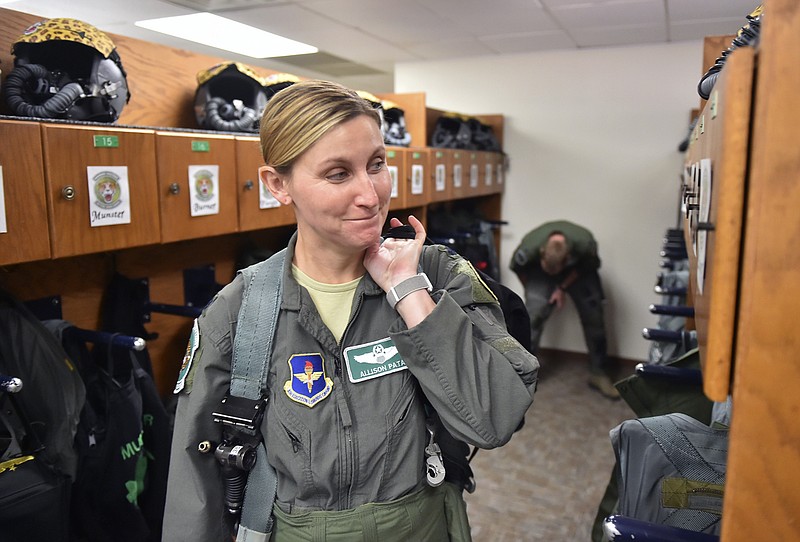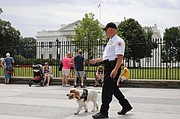SAN ANTONIO-Maj. Bri Peterson and her husband, Grant, awaken before dawn on work days to care for their young son before they head off in different directions from their New Braunfels home.
The San Antonio Express-News reports Bri, a T-1 instructor pilot, commutes to Joint Base San Antonio-Randolph, where she is the 12th Training Squadron's staff director.
Grant drives to a camera exchange store on San Pedro Avenue in San Antonio. Bri brings their toddler, 18-month-old Gavin, to an on-base day care center.
Bri's career is on the rise, while Grant's is in a holding pattern.
When Bri gets orders to move to a new base, Grant loses his job. He once was cut loose from a store in Mississippi because he took three weeks off for their honeymoon. Now she sees him about four hours a day during the week-and her son less than that.
They get one day a week together-Sunday.
Their routine reflects the type of stressful lifestyle that is causing an exodus of women from the Air Force, which is trying a range of solutions to reduce the attrition. A RAND Corp. study found that women leave the service earlier than men because of conflicts that tear at their families and personal lives.
The study found a significant drop-off in the number of women serving as the years pass. Twenty percent of second lieutenants are women, but many leave the service before they can advance up the ladder, reducing their ranks to only around 14 percent of the lieutenant colonels and colonels. About half of that number will make one-star general, meaning that nine in every 10 general officers will be men.
Furthermore, half of all male officers serving in nonflying jobs remain in the Air Force through 10 years, while 37 percent of women do. For flying-rated jobs, 63 percent of male-rated officers remain in the Air Force after 13 years, while 39 percent of women in that field are still in uniform.
Veteran pilots, who cannot leave the service until completing a decade-long service commitment, are exiting in droves, leaving the Air Force with a shortage of 2,000 pilots. Many head for lucrative jobs as commercial airline pilots.
Research examining gender differences in retention has put a spotlight on issues important to women-marital and family status, work-family balance and frequency of deployments, and permanent change of station, called PCS, that force civilian spouses to scramble for a new job. Frequently, dual-military couples end up working at different bases hundreds or thousands of miles apart.
Changes have been made. The Air Force extended maternity leave from six to 12 paid weeks two years ago as part of a sweeping Pentagon directive. Under the new policy, it also deferred fitness tests and deployments for a year after giving birth. Those tests had been required six months after delivery.
RAND made a host of recommendations, one of which would reduce the frequency of PCS orders. Others call for considering a couple's parental status in deployment decisions, expanding child care and providing greater career flexibility. One idea would allow airmen to work in a technical specialty rather than move up the ranks into managerial jobs.
Retired Maj. Gen. Susan Pamerleau, a former commander of the Air Force Personnel Center on Randolph and a former Bexar County sheriff, cautioned that any deviation from the way people progress in the military's "up-or-out" career track, including allowing some to work exclusively in technical jobs, could cost the service good leaders.
"There's no way to just come to a halt and say, 'OK, I'm not going any farther but now I can stay for as long as I want,'" said Pamerleau, the fourth woman in the active-duty Air Force to become a two-star general.
"There are two things it can do," she continued. "It can stagnate the opportunity for others to move up. And the second part is it has the potential to limit the numbers of ways to be considered for senior leadership positions."
Gen. David Goldfein, the Air Force chief of staff, said efforts under underway "to look at outdated policies that drive women away from serving and eroding readiness," such as reducing strict pregnancy limitations for flying and offering career intermission programs to keep experienced airmen.
The Air Force also is studying uniforms and equipment to ensure they're appropriately designed for all airmen.
Women have long had to use equipment designed for men.
"To me this is a joint war-fighting imperative," Goldfein said.
"We must retain our most talented officers and NCOs so we have the diverse leadership required to find creative solutions to complex challenges."
One of the latest innovations: A tan- or sand-colored breastfeeding T-shirt women can use with their utility uniforms.
Like many women in the Air Force, Bri Peterson, 35, grapples with problems that seem to defy solution-the uprooting of her family every few years for a new assignment; the ordeal of finding on-base child care; resolving occasional conflicts between work and family; and watching her husband launch yet another job search.
"It's a struggle we're going to face every time I get orders, that he's going to have to leave whatever job he's in and find a new job," she said.
Day care is another headache. Before moving to Randolph, the couple enrolled Gavin in one of the base Childcare Development Centers. Almost a year passed before they got an offer in May.
"Fortunately, my mom is retired; so she was able to come down and take care of our son for us," Peterson said.
A private breastfeeding place at work also would be helpful, which was noted in the study.
"The fact that they highlighted the point that the breastfeeding room should not be a bathroom. When I had my son, my last squadron, it was a bathroom in a building with ... only two women's bathrooms," she said. "So I was in there for however long it took me to close down an entire bathroom in the building."
Finally, the biggest challenge is whenever Grant loses his job. It happens every time they move and will be a recurring feature of their lives as long as Bri is in the service. They could get a new assignment as early as next year, forcing him to quit the camera exchange store and start over.
"He's very supportive of my career, and he knows it's something that has to happen until I separate from the military," said Bri, who has more than 2,600 flying hours in the C-17 cargo plane, T-1 training jet and other aircraft. "He's got the experience in order to be the next-level manager in running multiple stores, but because we move around so much, that's not a position he's going to get hired to do until we stop moving."
Peterson and two fellow pilots in her wing, Maj. Lindsay Andrew and Lt. Col. Allison Patak, said they plan to stay in the service until they retire, despite the challenges.
They said they want Air Force careers, not jobs in the civilian world. The inflection point for pilots, who have a 10-year service commitment, comes after 12 or 13 years in the ranks.
"That particular time frame, in which the women leave at about double the rate of men, there's a lot of things that happen," said Andrew, 36, of Marion. "For pilots, it is the first time that we are allowed out of our pilot commitment, so the 10-to 12-year mark is when a lot of women leave.
"The Reserves offer a lot of opportunity and a lot more flexibility than the active-duty does; so a lot of it is outside opportunity. And then on top of that is the military lifestyle is not very conducive to raising a family, and it is the prime childbearing, child-rearing years as well; so there are a lot of outside influences, and it just happens to all be at that same time frame."
A T-1 instructor pilot with 3,200 hours in the air, 300 in combat, Andrew came close to quitting. She was 4 months pregnant with twins when commanders told her that she would remain at Laughlin AFB in Del Rio for a year while her husband, Jonathan, 35, an Air Force major who flies the T-6A Texan II, got orders to move to Randolph, almost 200 miles away.
She faced the prospect of having to raise their twins, Fisher and Levi, now 2, alone for at least the first six months before having a chance to move to San Antonio with her husband. Rather than take a pilot retention bonus and remain in the Air Force, she thought of leaving so she could remain with her husband.
"I kind of was pegging that as my sign that my service was no longer needed in the Air Force if they were going to do that, especially because I knew that there were positions here at Randolph that I should have been able to fill," Andrew said.
One thing saved her-connections. She had a friend who worked at the Air Force Personnel Center at Randolph who could match jobs with her specialty. She also had friends in high places at Laughlin and turned to them.
Andrew, who spent the first two years of her marriage separated from her husband, was determined it wouldn't happen again.
"I was fortunate at the time that I had a good friend that was an assignments guy at AFPC so I did have somebody that I could talk to and that kind of helped me navigate that situation, but not everybody knows somebody, not everybody has a phone number they can call where somebody answers and helps them," she said.
Multiple surveys have addressed the usual problems that prompt many women to leave: compatibility with their spouse's job or career, maintaining work-life balance and meeting family obligations.
The RAND study also found that some women quit rather than report a sexual assault. Nearly four in every 10 focus groups in the study ranked it as a critical concern, with a majority recounting encounters of harassment in male-dominated units and career fields. The vast majority of the focus groups also talked of long hours or shift work, with duty days of up to 12 hours that led to burnout and divorce.
And female role models were often missing for Air Force officers.
Patak, 39, didn't have a female adviser to help thread her way between her work and home priorities. The problem grows as careers progress, forcing people to make difficult decisions.
"I didn't have anyone I could talk to about how do I balance my career and kids and timing and how do I make this work," she said.
Other women who manage career responsibilities while moving up the Air Force ranks tell similar tales. It's especially difficult for husbands and wives who are both serving in the military. In time, one person's career will ascend beyond their spouse's, forcing a decision.
Should the "trailing spouse" bail out for the sake of the family?
"If you're talking about the military, you do get to a point where it's very difficult to both stay in, stay in the same place and have successful careers. It's just extremely hard. And that's mostly because as you go up in rank, the different positions of leadership are not necessarily in the same place," said Air Force Lt. Col. Catie Hague, whose husband, Nick Hague, is an Air Force colonel who will fly to the International Space Station this fall.
"From the standpoint of the general comment of why women get out is you get to a point where you have to make a decision and stability of the family winds up being a lot of that decision," she added. "That's why women leave, because of stability of the family. Then you get to a point where you're getting older and your kids are getting older and you don't want to pull them out of high school and you've moved nine times and it's time to settle."
The Hagues, who live in the Houston suburb of Friendswood, spent seven of their 20 years in the Air Force apart. The hardest separation yet for Catie Hague, a public affairs officer, was the year she served in Iraq when her first child was 1. She and Nick, a flight test engineer, Iraq veteran and an astronaut since 2013, talked on Skype.
She missed her son's first words and his first steps.
"There have been many times in my career, and I even think Nick's had people say this to him, where we had people tell us, 'Hey, you know what? At some point one of you has to get out. You can't both have a successful career,'" Hague recalled. "And I'm pretty stubborn so my answer to that is always, 'Why not? Why can't we both still serve if we want to?'"
Around the time Nick Hague's six-month tour aboard the International Space Station ends with a 45-day rehabilitation period, Catie Hague will get orders to PCS from her job as the commander of a University of Houston Air Force ROTC detachment. Up for promotion to full colonel, she could be sent far from Houston.
Nick Hague will remain at Johnson Space Center as a member of NASA's astronaut corps.
Hague is counting on people in the Air Force leadership and in NASA stepping in to help her stay in Houston. There are no guarantees, and if she can't move up to colonel or avoid a major move, it might be time to move out, fulfilling the admonition of old friends.
"If I don't get promoted," she said, "I'm probably retiring."
A typical day in the life of Allison Patak, an A-10 and T-38 Talon pilot who just moved to Colorado Springs, Colo., for a flying assignment, is a study of an Air Force work-life balance high-wire act.
She soon will drive 40 miles south on Interstate 25 to the squadron headquarters in Pueblo every weekday. Lt. Col. Dan Patak, who also has flown the A-10 and T-38, will have a 25-minute commute in the other direction to the Air Force Academy.
Earlier this year, Dan was out of town a lot as he took time off from the Air Force, leaving her to fly solo with Finn, 6, and Zane, 10, in tow.
Those days, when they lived in Cibolo, would leave her breathless and sleep deprived.
"So, you know, I get up, I have to get the kids to school in the morning, then I come to work. I do my work day, I pick them up, I take them to get food as quickly as we can because I'm trying to maximize my time at work, but I also have commitments with my sons to get them to practice because they play sports," Patak said.
"And so I feed them as quickly as I can, I take them to sports and some nights we don't get home until 8 o'clock or later, and then it's me getting them to bed and then a lot of times at some point in that evening-whether it's at their ball practice or later when I get home-going back and checking my work email to see what I might have missed since I left the office. And then rinse, repeat, the next day, and that's a lot when it's day after day after day after day."
Dan could deploy while at the Air Force Academy, but this time Allison will have help. Her parents live in Colorado Springs.
"It's not necessarily fun," she said, "but it's doable.



